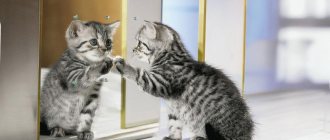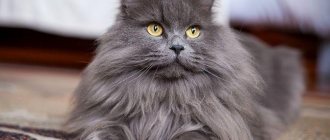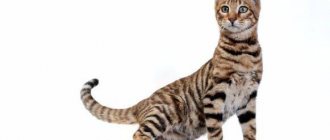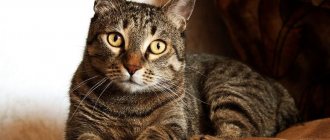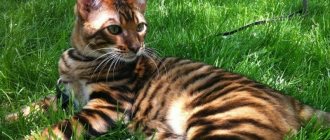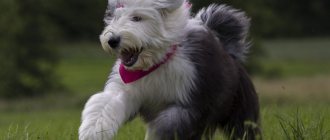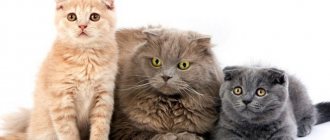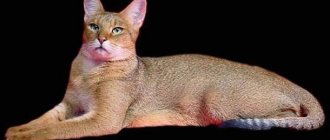Features and genetics of color
The merle is a variation of the repeatedly described tabby color. Read the article about tabby cats, there you will find information about this color and its types.
Characteristics common to all tabby colors are thin lines on the muzzle, which clearly outline the upper and lower eyelids, and form a characteristic letter “M” on the animal’s forehead. Scientists believe that the original cat species had this pattern on the skin, which is why it is often called “wild”.
When a cat's fur is in unusual patterns, that is, there are large concentric or spiral circles on the sides, 3 parallel clear stripes along the ridge line, rings on the paws and spots on the belly, the color is called marbled or classic tabby.
How are cats with this pattern bred?
Of all the tabby varieties, the marbled cat color is the most recessive. Therefore, in order to get kittens of the desired color, when crossing, marbling of both parents is required - then the kittens will definitely have the desired pattern. Matings in which one of the parents is spotted or brindle is somewhat less effective. When mating only brindles, all kinds of kittens will be born - “tigers”, and spotted ones, and “marbles”, if, of course, the parents have the right gene. Crossing a brindle sire with a spotted one will give the same results, but a pair of spotted sires will only produce marbled sires and others like them.
Types of merle color
Marble color, in turn, has many varieties. First of all, it is divided into regular and tortoiseshell.
The regular one, in turn, differs in color:
- Black marble - charcoal lines on a dark brown main background. The eyes and the outline of the red-brown nose are outlined. Eyes - yellow, orange, brown.
- Chocolate marble - a pattern of dark chocolate on light. The lining is thick brown. The eyes are the same as those of a black marble, the paw pads and nose are brick-colored.
- Cinnamon marble. The background is light honey, the pattern on the fur and the lining of the nose and eyes, the paw pads are cinnamon. Eyes yellow tones.
- Red marble. Bright red pattern on a red background. The same outline and paw pads, eyes of different shades of yellow and orange.
- Cream. Very similar to red, only all the tones are gentle, muted.
- Blue. The main background is beige shades. The pattern on the coat, the lines on the muzzle, and the paw pads are blue or gray. The eyes are yellow and brown. Paw pads are dark pink.
- Lilac. The background is silver, the design, outline and nose are lavender. The paw pads are soft pink. Eyes are yellow and brown.
- Faun marble. On a pale yellow background of fur, there are fawn-colored streaks, the outlines on the muzzle and the paw pads are pink. Eyes copper, orange, brown.
Tortoiseshell marble differs from ordinary marble in that the background color has two colors:
- Black turtle - the background in this case is red and brown, and the design is black and bright copper.
- Chocolate - the background and designs of chocolate and red are mixed.
- Cinnamon has a honey and red background; the designs also differ in color saturation.
- Blue - beige and peach background with patterns.
- Lilac - lavender and peach and patterns of varying saturation.
- Faun - ivory and peach with streaks.
Tortoiseshell marble is not the prerogative of females, since there are not three colors, but usually varieties of two.
Security status
Hunting of this species is prohibited in the following countries: Bangladesh, Cambodia, China (Yunnan only), India, Indonesia, Malaysia, Myanmar, Nepal and Thailand. The marbled cat is listed on Appendix I of the Convention on International Trade in Endangered Species (CITES), which prohibits international trade in the species. Marbled cats are rarely found in zoos and do not breed well in captivity.
The marbled cat is an incredibly beautiful wild cat of Southeast Asia. Inhabits tropical and subtropical forests of Nepal, Burma, Thailand, Malaysia, Sumatra, Borneo and India.
Based on DNA results, zoologists determined that this species, despite its small size, should be classified as a big cat (Pantherinae), although previously it was mistakenly considered a representative of the subfamily Felinae.
The size of the marbled cat is slightly larger than that of domestic pets. The length of their graceful body is about fifty-five centimeters. Moreover, the thick tail has approximately the same dimensions. Such a massive part of the body is simply necessary for a cat to live in the forest, because it is responsible for the balancing function. The body weight of the marbled beauty ranges from four to eight kilograms.
The graceful body of the animal is covered with soft thick fur. Against the background of yellow-golden fur there are large, unevenly outlined black spots. On the sides of the cat the pattern is paler, and the belly and chest have a lighter background. Visually, this marble pattern is similar to the color of another feline representative -.
The cat's head is small and round. The back of the ears is black with characteristic large white spots. The upper fangs are long, this is especially noticeable when the animal grins. Eyes the color of walnut shells. Powerful short legs and tail are completely dotted with black spots, and on the tail they are noticeably larger. Marbled cats live up to twelve years.
The marbled cat spends most of its life in trees. It is not difficult for her to move along the branches. Like many cats, they lead an active lifestyle at night. They prefer privacy. Each individual has its own territory for hunting, an area of approximately six square meters. kilometers. The cat's diet consists of bats, tree squirrels, birds, small reptiles, amphibians and insects. The marbled cat has excellent hearing. She can pick up the sounds made by the prey before it comes into the cat's field of view.
Marbled cats become sexually mature at the age of twenty-one weeks. Mating in marbled cats occurs once a year, regardless of the season. After about eighty days, one to four kittens are born, weighing about one hundred grams. Babies are born blind, deaf and with a uniform coat color. On the fifth day, the cubs develop hearing, and after two weeks they acquire vision. Already at the age of four months, the kittens' fur coat acquires a traditional marble pattern. Babies feed on mother's milk for up to three to four months, then they are ready to move on to solid food.
The marbled cat is a small animal, the size of a domestic cat. But, despite its modest size, the marbled cat is a harsh beast, because its closest relatives are pumas and leopards. And due to the fact that it lives in my favorite region - Southeast Asia, I could not pass by and not write about this rare representative of the cat family.
Difficulties of breeding
Since this color is recessive, two marbled parents produce exactly the same kittens. But it often forms in spotted or tabby mackerel. That is, absolutely all tabbies are carriers of the classic marble, and it is impossible to predict which pair will give birth to which kittens.
Another difficulty in obtaining marble is that the intensity of color and contrast also does not lend itself to any pattern.
Another problem is that the stripes of the pattern become too wide, covering the entire body, and the main background is visible through them in thin stripes. The animal does not lose its beauty, but by breed standards it loses. Therefore, to obtain beautiful marbled kittens, experienced breeders carefully select producers, carefully studying their pedigree.
British among cats
This breed is popular due to its independent and patient disposition, because British women will never get bored in the absence of their owner. At the same time, plush purrs are not devoid of a sense of tact and show full love to those who take care of them and treat them with tasty treats.
British cats are the embodiment of calm and intelligence
The British are distinguished by high intelligence - by changing the “notes” in the breadwinner’s voice, the cat will understand that it is doing something wrong. However, these little cats cannot be called too mischievous or vindictive - calmness is their strong point. At the same time, British cats are not inclined to become toys in children's hands; with excessive attention from children, the cat will prefer to run away.
Externally, British catfish differ in the following parameters:
- thick coat with dense undercoat;
- round, close-set eyes of amber color;
- massive head on a short neck;
- wide cheekbones;
- small nose with a wide bridge;
- ears widened at the base with rounded tips;
- muscular body on wide, strong legs;
- medium-length tail, rounded at the end.
Mr. Cat Recommends: False Marble
With a tabby pattern, each hair is ticked and painted in several colors. If it is excessive, the marble pattern turns out to be shaded, as if supported by a film or fog.
This blurriness is called moiré or false marbling in the British breed.
For Bengals, this phenomenon is called phasing, and it has a different character. The ticked undercoat covers the main color, but it definitely goes through. Moreover, it is marbled kittens that flourish earlier than others - spotted, rosette.
But British moire patterns can remain “shaded” for life. No one can predict whether a baby will get ticking or not. Therefore, it is better to purchase marbled British kittens, straights or Scottish, later - by 4-6 months.
About character
In the photo , cats of the British breed always delight with their calm gaze.
This look conveys the true English character: delicate and unobtrusive. Cats love their owner, but try to remain as independent as possible. They prefer to spend time quietly, enjoying warmth and comfort.
Most British marbled cats are playful. But they are reluctant to be held, especially by strangers. Although cats do not show aggression, even if something happens against their will. True aristocrats always show amazing restraint, which is why their owners love them so much!
Some breeds and types of marble
The merle color is found in various varieties in many domestic cat breeds.
Bengal marble
He is very unique. These hybrid cats have primary color patterns of gold, silver, snow and charcoal, but always with a tabby pattern. These can be bright spots, peculiar “rosettes” or various stains. That’s why they call marble “on gold”, “on silver”, snow and coal.
The type of pattern itself is also different. If you don’t delve into the special terminology, but accept the generally accepted one among breeders, then it can be of the “cloak” and “sparble” type.
Cloak marble is the most inexpressive pattern, when dark lines practically merge and overlap the main background. Such animals are poorly valued.
But sparbles are highly valued. These cats can be said to combine large two-color rosettes and large concentric circles on the sides, belonging to true classic marble. Usually such animals are the brightest and most expressive in the litter, with bright glitter.
Bengals do not have tortoiseshell marbles.
British marble
It is common in closely related breeds - the British and the Scots, which differ only in the shape of the ears; in the latter they are bent forward and hang down.
This is one of the oldest breeds of domestic cats in Europe. Received by crossing street, English and Persian individuals. The structure of their short, printed coat with abundant undercoat is reminiscent of teddy bears.
By nature, these animals are quite capricious, lazy, independent and picky. But with proper training, they make excellent pets.
The merle color can be regular or tortoiseshell. It is these breeds that have the greatest difficulties in breeding this color due to the moire factor.
Asian tabby
The name of the breed itself speaks about the color characteristics. Bengal wild type marbles are common. But moire is quite common, since the breed was obtained by crossing a Burmilla and an Abyssinian, which is distinguished by high ticking.
These animals are very active, playful and restless. They are extremely attached to their owner and distrustful of strangers.
American Bobtail
It is also distinguished by a variety of colors, among which marble in various color variations is not the least important.
This is an American breed, bred in the 50s of the last century. The main distinguishing feature is the short tail, which is often called a bob. The coat can be short or medium length.
Smart, sociable, independent pets are excellent companions for all household members.
Read more in the article about American Bobtails.
Bramble
This very young breed (2000) bears the name of its creator Harry Bramblett. In addition, it is also used in consonance with the English word for “thorn” - “bramble”.
Obtained by crossing a Bengal cat and a Peterbald with a brush coat. Therefore, the marble of these cats is of the Bengal type, and the fur itself resembles a hard wire in appearance, but is soft to the touch. This is currently an experimental and very rare variety.
In character they are unusually reminiscent of Bengal.
Bohemian rex
Extremely rare animals. They were bred in the 80s of the last century, but breeding work has practically ceased.
They descended from short-haired Persians with a rare gene for curly hair, apparently accidentally introduced during crossings during the selection of German Rexes.
Very cute and obedient pets come in a variety of colors, including marbled ones.
Devon Rex
Can also be marbled. It was this breed that was formed due to a random mutation.
This was discovered when an attempt was made to cross them with Cornish Rex. The genes of the two species turned out to be different; the desired result did not work out.
Like all curly-haired cats, Devon Rexes resemble in their behavior the symbiote of a monkey, a dog and a cat. Cheerful, energetic, restless pets are loving, intelligent and trusting.
Napoleon
This amazing animal only recently received the title of a provisionally recognized breed six years ago, but has won the love of the whole world due to its unusual appearance and chic character.
American breeder Joe Smith crossed Persians and Munchkins to get a long-legged variety of the latter, but the result was short-legged Persian cats that absolutely did not inherit the warlike and harmful temper of their ancestors.
The colors of the breed are varied, marbled Napoleons are one of the most beautiful cats in the world.
Other breeds
These are not all breeds, among whose representatives marble beauties are often found. These also include:
- American Shorthair and Wirehair;
American shorthair cat
- American Curl;
- Brazilian Shorthair;
- European Shorthair;
- California radiant;
- Kanaani;
- Karelian, Kuril and Japanese bobtails;
Two Karelian bobtails
- Cymric;
- Laperm;
- Lamkin;
- Munchkin;
- Manx;
- Maine Coon;
- Norwegian Longhair;
- Oriental and many others.
